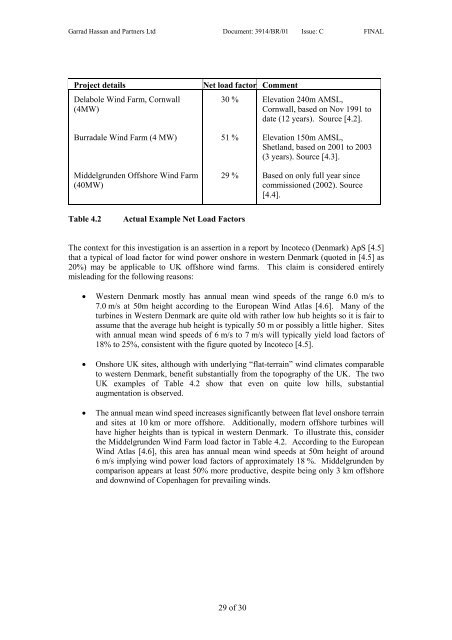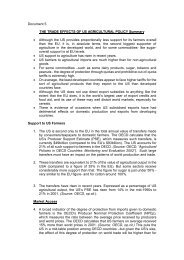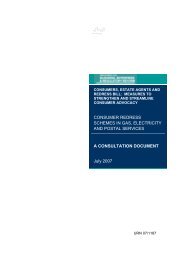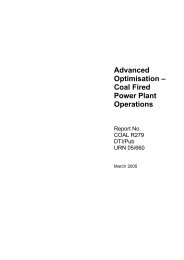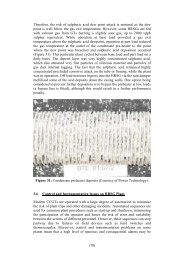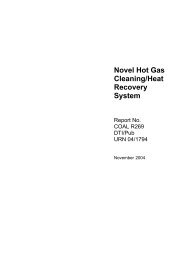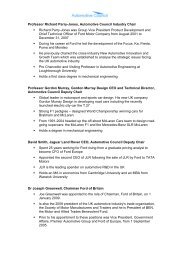OFFSHORE WIND Economies of scale, engineering ... - CiteSeerX
OFFSHORE WIND Economies of scale, engineering ... - CiteSeerX
OFFSHORE WIND Economies of scale, engineering ... - CiteSeerX
Create successful ePaper yourself
Turn your PDF publications into a flip-book with our unique Google optimized e-Paper software.
Garrad Hassan and Partners Ltd Document: 3914/BR/01 Issue: C FINAL<br />
Project details Net load factor Comment<br />
Delabole Wind Farm, Cornwall<br />
(4MW)<br />
30 % Elevation 240m AMSL,<br />
Cornwall, based on Nov 1991 to<br />
date (12 years). Source [4.2].<br />
Burradale Wind Farm (4 MW) 51 % Elevation 150m AMSL,<br />
Shetland, based on 2001 to 2003<br />
(3 years). Source [4.3].<br />
Middelgrunden Offshore Wind Farm<br />
(40MW)<br />
Table 4.2 Actual Example Net Load Factors<br />
29 % Based on only full year since<br />
commissioned (2002). Source<br />
[4.4].<br />
The context for this investigation is an assertion in a report by Incoteco (Denmark) ApS [4.5]<br />
that a typical <strong>of</strong> load factor for wind power onshore in western Denmark (quoted in [4.5] as<br />
20%) may be applicable to UK <strong>of</strong>fshore wind farms. This claim is considered entirely<br />
misleading for the following reasons:<br />
Western Denmark mostly has annual mean wind speeds <strong>of</strong> the range 6.0 m/s to<br />
7.0 m/s at 50m height according to the European Wind Atlas [4.6]. Many <strong>of</strong> the<br />
turbines in Western Denmark are quite old with rather low hub heights so it is fair to<br />
assume that the average hub height is typically 50 m or possibly a little higher. Sites<br />
with annual mean wind speeds <strong>of</strong> 6 m/s to 7 m/s will typically yield load factors <strong>of</strong><br />
18% to 25%, consistent with the figure quoted by Incoteco [4.5].<br />
Onshore UK sites, although with underlying “flat-terrain” wind climates comparable<br />
to western Denmark, benefit substantially from the topography <strong>of</strong> the UK. The two<br />
UK examples <strong>of</strong> Table 4.2 show that even on quite low hills, substantial<br />
augmentation is observed.<br />
The annual mean wind speed increases significantly between flat level onshore terrain<br />
and sites at 10 km or more <strong>of</strong>fshore. Additionally, modern <strong>of</strong>fshore turbines will<br />
have higher heights than is typical in western Denmark. To illustrate this, consider<br />
the Middelgrunden Wind Farm load factor in Table 4.2. According to the European<br />
Wind Atlas [4.6], this area has annual mean wind speeds at 50m height <strong>of</strong> around<br />
6 m/s implying wind power load factors <strong>of</strong> approximately 18 %. Middelgrunden by<br />
comparison appears at least 50% more productive, despite being only 3 km <strong>of</strong>fshore<br />
and downwind <strong>of</strong> Copenhagen for prevailing winds.<br />
29 <strong>of</strong> 30


